Aspect of Reproductive Biology of Chrysichthys nigrodigitatus (Lacepède 1803) in Asejire Reservoir, Nigeria
| Received 14 Sep, 2023 |
Accepted 29 Dec, 2023 |
Published 31 Dec, 2023 |
Background and Objective: Knowledge of fish reproduction is crucial to survival and abundance for sustainable use. Thus, a study on the sex ratio, size structure and gonad somatic index (GSI) of Chrysichthys nigrodigitatus in Asejire Reservoir was conducted in Asejire Reservoir, Nigeria to provide information on aspects of reproductive biology for sustainable management. Materials and Methods: The 251 samples of Chrysichthys nigrodigitatus were randomly collected from fishers’ catch for seven months covering the wet and dry seasons of 2022 to assess sex ratio, size structure and gonadosomatic indices following standard procedures. Data generated were analysed using descriptive and inferential statistics at α0.05. Results: Samples examined had a joint sex ratio of 1:1.5 indicating a more dominant female population across both seasons. The GSI value ranged from 0.53-9.75 (wet) and 0.31-10.69 (dry) while the correlation coefficient between the GSI and body weight was 0.45 (wet) and 0.20 (dry). The result revealed a positive correlation across all relationships except between the GSI and weight in the dry season. Conclusion: The study provides crucial reproductive insights for managing Chrysichthys nigrodigitatus and suggests exploring its aquaculture potential through additional research.
| Copyright © 2023 Nurudeen and Kareem. This is an open-access article distributed under the Creative Commons Attribution License, which permits unrestricted use, distribution, and reproduction in any medium, provided the original work is properly cited. |
INTRODUCTION
Fishes are food sources rich in nutritional value for young and aged people around the globe. Data revealed that fish represent a major animal protein supply for the world's majority. The nutritional content in fish puts it in pole a position to help fight hunger and malnutrition, especially in Africa. Fish is one of the valuable healthy diets rich in essential amino acids and cherished for its impact on human health1. Fish is one of Africa’s cheapest animal protein sources2. It is unfortunate that the protein requirement of most African countries still grossly outweighs its supply.
The increase in human population and awareness of fish food quality has significantly made fish demand scale up. However, the fish demand-supply gap has been redeemed by aquaculture production, which recorded 120.1 million metric tonnes in 20193. Catfishes are commercially and economically important inland fish species considered for aquaculture in Nigeria. Chrysichthys nigrodigitatus is one of the highly sought catfish appreciated for its food and commercial purpose4.
The silver catfish, Chrysichthys nigrodigitatus (Lacépède) occurs in most of the major rivers in Africa including Nigeria, Senegal, Gambia, Ivory Coast, Liberia, Zaire and Gabon5. Knowledge of their biology is important for management and sustainable utilization of stock. For this reason, Famoofo and Abdul6 and Ajagbe et al.7 carried out biological assessments to determine the quality of populations of the species in different water bodies in Nigeria. Ikomi and Odum8 in their studies give insight into the type of food consumed by Chrysichthys auratus in captivity, while Olele et al.9 probed into the chemical and biological properties of Chrysichthys furcatus from River Niger, Nigeria. All these efforts were made towards conservation and sustainable utilization of the stock.
Similarly, there have been several bodies of work on different fishes like the Sex Ratio, Gonadosomatic in Diet Composition and Fecundity of African Pike, Hepsetus odoe in Eleyele Lake, Nigeria by Kareem et al.10 and similar studies on Parachanna obscura11, Synodontis Shall12, Labeo coubie13, Clarias gariepinus and Clarias macromystax14. However, there is less work on the bionomics of C. nigrodigitatus especially in Asejire Reservoir. Due to the dwindling nature and the complaints by fishermen on the reduction of the resources over the years, it became obvious to embark on this study to provide information on the status and reproductive biology of this species in the study area for proper management and conservation in the water body. The ongoing commercialisation of this fish in the riverine areas has contributed to the economy of the fishing community. A lack of proper management and documentation of the fishing of this resource has led to a decline in its population, which could ultimately lead to biological, social and ecological problems.
Studies on the aspect of the reproductive biology of C. nigrodigitatus will provide information on productivity, longevity, period of maturity, recruitment of various classes and determination of potential yield. There is, therefore, a need to properly assess the stock of Chrysichthys nigrodigitatus in the wild, which informs the current study. This study is therefore to investigate some aspects of reproductive biology such as the gonadosomatic index, Sex ratio and size structure of C. nigrodigitatus population in Asejire Reservoir.
MATERIALS AND METHODS
Study area: This study was carried out from January to July, 2022 in Asejire Reservoir. The Reservoir is a major artificial dam constructed on River Osun which links the Ogun River and drains ultimately to the Lagos Lagoon in South Western Nigeria. It lies at the borderline between Oyo and Osun States of Nigeria. The lake receives supply from River Osun and Oba dam at the left arm, while Agbora arm feeds the dam from the right, making the reservoir have a Y shape when viewed from the point of impoundment. Its entire length is 11.2 km, the catchment area above the dam is about 7,800 km2 and the impoundment area is 2,342 ha15.
Selection of samples: The 251 samples of C. nigrodigitatus at Asejire Dam were examined. The 125 and 126 samples were collected during the wet and dry seasons, respectively. They were obtained from catch landings of fishermen who fished both during the day and at night using mostly artisanal fishing gear such as beach seines, gill nets, cast nets and fish traps. The fish were transported in an ice box from the site to the Wet Laboratory of the Department of Aquaculture and Fisheries Management for further examination.
Determination of length-weight and sex ratio: The body length and weight of the specimens were taken. The standard and total lengths (in centimetres) were measured on 60 cm measuring board manufactured by PENTAIR Aquatic Ecosystem, Florida, United States of America. The weights (in grams) were also determined using sensitive weighing balance produced by Camry (EK5350) from Cheung Sha Wan, Kowloon, Hong Kong. The sex of each sample was identified by visual examination and separated based on external morphology. The sex ratio was calculated according to Kareem et al.11 using the formula:
Determination of size structure and gonadosomatic index: The gravid females were dissected and the ovaries were detached and weighed to the nearest 0.0l g for gonadosomatic index (GSI) study. The data on the body and gonad weights were used to compute the gonadosomatic index according to Al-Deghayem et al.16:
 |
Morphometric data including fish total length and standard length were taken for size structure using length-frequency distribution to show the proportion of fish collected.
Statistical analysis: Data obtained were subjected to descriptive analysis, a Chi-square test (used to determine if there is a significant difference between observed frequencies and expected frequencies. In the context of sex ratio comparison, it can be used to assess whether the proportion of males and females in a fish population deviates significantly from an expected ratio (e.g., 1:1 for an equal sex ratio), linear regression (used to model the relationship between a dependent variable and one or more independent variables-GSI and weight/length) and correlation analysis at 5% significance level (α0.05). The growth pattern of the fish specimens was determined using the equation described by Froese17, thus:
W = aLb |
(1) |
Where:
| W | = | Total weight of the fish (g) | |
| L | = | Standard lengths (cm) | |
| a | = | Regression constant which is also the intercept | |
| b | = | Regression of the coefficient |
The above curvilinear equation was transformed to a linear relationship using logarithmic transformation thus:
Log W = Log a+b Log SL |
(2) |
RESULTS
Sex ratio of Chrysichthys nigrodigitatus: The 251 samples of C. nigrodigitatus at Asejire Dam were examined. The 125 and one 126 samples were collected during the wet and dry seasons, respectively. The dry and wet seasons had a sex ratio of 1:1.03 and 1:1.27, respectively. This indicates that females are more dominant in the population. There was only a slight difference between the recorded sex ratio and the expected ratio of 1:1 at p<0.05.
Size structure: The total length of C. nigrodigitatus ranged from 17.00-56.30 cm (wet) and 16.40-52.60 cm (dry) while the total body weight ranged between 62.00-546.00 g (wet) and 25.00-443.00 g (dry) (Table 1). There was no significant difference between the 2 seasons at p>0.05. A strong positive relationship was observed between weight and length during dry (r = 0.840) and wet (r = 0.927) seasons (Fig. 1 and 2).
Gonadosomatic index (GSI): The Gonadosomatic Index (GSI) result calculated show a value ranging from 0.53-9.75 and 0.31-10.69 during the wet and dry season, respectively. The correlation coefficient between the GSI and Body weight was 0.45 and -0.20 in the dry and wet seasons, respectively while the correlation coefficient between the GSI and length was 0.42 and 0.42 in the dry and wet seasons, respectively.
| Table 1: | Seasonal statistics on growth pattern of Chrysichthys nigrodigitatus in Asejire reservoir | |||
| Parameters | Wet |
Range |
Dry |
Range |
p-value |
| Weight | 188.00±97.83 |
62.00-546.00 |
171.05±107.29 |
25.00-443.00 |
0.2 |
| Total length | 31.38±9.54 |
17.00-56.30 |
29.11±8.73 |
16.40-52.60 |
0.05 |
| Standard length | 27.12±8.76 |
15.01-48.80 |
23.71±7.60 |
13.40-44.80 |
0.01 |
| a | 0.11 |
0.51 |
|||
| b | 0.59 |
0.4 |
|||
| r | 0.93 |
0.84 |
|||
| r | 0.96 |
0.92 |
|||
| Growth pattern | NA |
NA |
|||
| Sex ratio | 01:01.3 |
01:01.0 |
|||
| NA: Negative allometric, a: Intercept, b: Slope, r: Correlation coefficient, r2: Correlation determination and Significance difference at p<0.05 | |||||
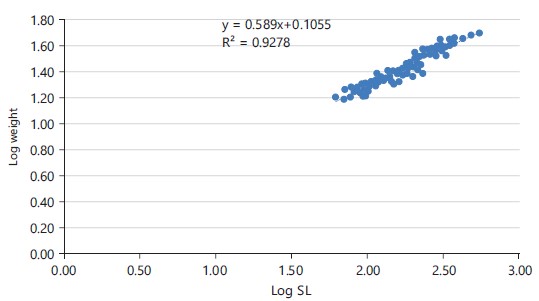
|
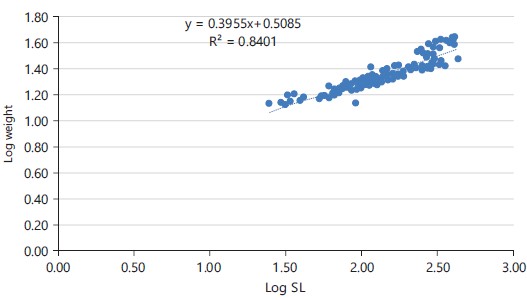
|
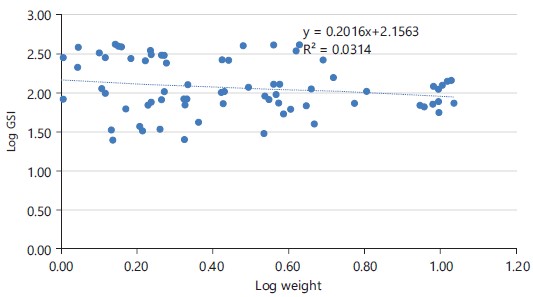
|
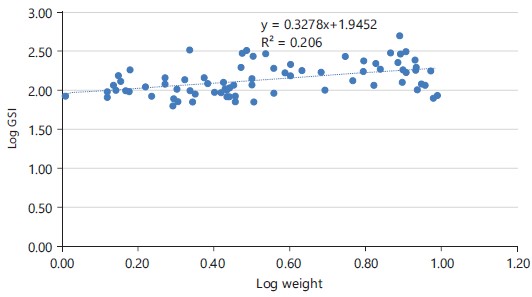
|
Relationships between gonadosomatic index on total length and body weight of Chrysichthys nigrodigitatus from Asejire Dam: The relationships of GSI on the length and weight of C. nigrodigitatus are shown in Fig. 3-6. The regression equations of the parameters are also shown in Table 2. The relationship revealed that GSI on length had a similar pattern in the two seasons but slightly different in weight. The regression equations for GSI/total length and GSI body weight in dry season are GSI = Log GSI = 1.31+0.21 L, R2 = 0.17 and GSI = Log GSI = 2.16-0.20 W, R2 = 0.03, respectively. The regression equations for GSI/total length and GSI body weight in wet season are: GSI = Log GSI = 1.26+0.18L, R2 = 0.17 and GSI = Log GSI = 1.94+0.33W, R2 = 0.21, respectively. The positive correlation (except the relationship between GSI and weight in the dry season, which was negative) value recorded for GSI for the parameters of length and weight is an indication that an increase in the weight and length will subsequently result in an increase in GSI of C. nigrodigitatus.

|
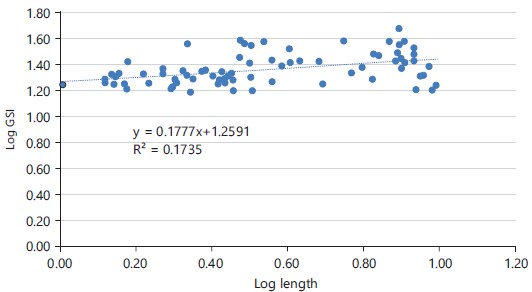
|
| Table 2: | Regression model for different variables of Length, weight and gonadosomatic index of C. nigrodigitatus at Asejire Dam | |||
| Season | Variables |
Regression model | R2 |
| Dry | W/GSI |
Log GSI = 2.16-0.20 W | 0.03 |
L/GSI |
Log GSI = 1.31+0.21 L | 0.17 | |
| Wet | W/GSI |
Log GSI = 1.94+0.33 W | 0.21 |
L/GSI |
Log GSI = 1.26+0.18 L | 0.17 |
DISCUSSION
The sex ratio values obtained in this study show a slightly more dominant female population than males. The dry and wet seasons had a sex ratio of 1:1.03 and 1:1.27, respectively. Overall, a 1:1.15 sex ratio was recorded. This indicates that females are more dominant in the population. There was a slight difference between the recorded sex ratio and the expected ratio of 1:1 at p<0.05. Almost equal samples were obtained across both seasons, with one more obtained in the dry season (125/126). More fish was recorded in the dry season than in the wet season. This was in direct contrast with the findings of Kareem et al.11 (1:1.55) across the seasons, which showed an almost doubled female species over their male counterpart as with Olowo et al.12 and Ikpi and Okey13. This study however compared favorably with Akombo et al.18 and Taiwo and Odunaiya19 where almost equal proportions of male and female numbers of these species were observed even though their abundance was in favour of female specimens.
The biological status of the aquatic environment largely depends on the physiological condition, dynamics of various life stages, productivity and growth patterns20. This makes having information on fish stock assessment ultimately very important. As found by Nahar et al.21 in Lates calcarifer, Olowo et al.12 in Synodontis schall and Kareem et al.10 in Hepsetus odoe, sexual dimorphism based on morphometric features is possible.
The total length of C. nigrodigitatus ranged from 17.00-56.30 cm (wet), 16.40-52.60 cm (dry) while the total body weight ranged between 62.00-546.00 g (wet) and 25.00-443.00 g (dry). The result revealed that the study fish species, C. nigrodigitatus grew better in the wet season. Statistically, there was no significant difference between the two seasons at p>0.05. A strong positive relationship was observed between weight and length during dry (r = 0.92) and wet (r = 0.96) seasons. Length-weight relations help prediction of potential yield and determination of size at capture for obtaining optimum yield, as these management parameters are directly related to the weight of fish. The relation is also useful in differentiating localities.
The Gonadosomatic Index (GSI) is a measure of the relative size of the gonads (reproductive organs) compared to the overall body weight of an organism often used to assess the reproductive condition and breeding activity of fish. The Gonadosomatic Index (GSI) values obtained in this study showed that the gonads were larger in the dry season. This result was contrary to that found in Wagle22 in their study of Schizothorax richardsonii and Offem et al.23 in their study of C. nigrodigitatus, whose gonads were larger in the wet season, confirming that the breeding and spawning exercises take place during the wet season. In this study, Gonadosomatic Index was found to be dependent on the size of the fish in all (length and weight) in both seasons which signifies that an increase in weight and length will subsequently result in an increase in GSI of C. nigrodigitatus. The dependent relationship of GSI and the size of yellow-edge lyretail grouper, Variola louti was also reported by Schemmel and Dahl24 in their study of Brycinus longipinis in Asa River, attributing the higher GSI in the larger samples to the heavier weight of their gonads.
A positive correlation in the result showed that as one variable increases, the other variable also tends to increase. In this case, it indicated that as the length and weight of Chrysichthys nigrodigitatus increase, the GSI also tends to increase. The result, however, mentioned an exception to the positive correlation observed between GSI and weight during the dry season suggesting that in that season, there is a negative relationship between GSI and weight, meaning that as the weight of the fish increases, the GSI decreases. This may indicat a different pattern of reproductive activity or physiological changes in response to environmental conditions during the dry season.
The GSI was also observed to be higher in the rainy season than in the dry season, thus, further confirming that breeding and spawning in these species might take place during the rainy season and not the dry season (due to the negative correlation observed). This observation agreed with that of Offem et al.23, who studied the dynamics in the reproductive biology of C. nigrodigitatus in the wetlands of Cross River, Nigeria.
The present study showed a significant contribution to the reproductive potential and stock size population of Chrysichthys nigrodigitatus in Asejire Reservoir, Nigeria. It provides information on the spawning period, which is critical to the rational and successful management of C. nigrodigitatus in both wild and aquaculture. The limitation of this study is essentially the shortage of funds to broaden the study to cover more areas reproductive biology of the fish. Thus, further research is needed to determine the fecundity, egg size and gonad histology for explicit data.
CONCLUSION AND RECOMMENDATION
In conclusion, a more female-dominated population was found across dry and wet seasons in the study area, with more fish sampled during the dry season. Chrysichthys nigrodigitatus showed positive allometry as regards GSI and length in both seasons’ but to GSI and body weight in the dry season. It was only negative in weight in the wet season, which shows that as the weight of the fish increases, the GSI decreases in the dry season. There was a positive correlation value recorded for GSI for the parameters of length and weight. The findings from the study thus indicate that breeding and spawning in this species might take place during the rainy season, which would in turn inform fishing decisions, ensuring that exploratory activities take place during the dry season.
SIGNIFICANCE STATEMENT
The study is significant for providing basic data required for assessing reproductive potential and stock size population of Chrysichthys nigrodigitatus in Asejire Reservoir, Nigeria. The data revealed an all-seasons female-dominated population in Asejire Reservoir. It was also discovered that C. nigrodigitatus grows better during the wet season. The findings from the study further show that breeding and spawning in this species might take place during the rainy season, which would in turn inform fishing decisions, limited exclusively to the dry season. The study has therefore provided crucial reproductive insights needed for managing C. nigrodigitatus and suggests ways of exploring its aquaculture potential.
REFERENCES
- Olanrewaju, A.N., 2022. Fatty acids and amino acids content of Heterotis niloticus (Cuvier, 1829) and Protopterus annectens (Owen, 1883) from Lake Alau, Northeast Nigeria. Biotechnology, 21: 59-64.
- Obiero, K., P. Meulenbroek, S. Drexler, A. Dagne and P. Akoll et al., 2019. The contribution of fish to food and nutrition security in Eastern Africa: Emerging trends and future outlooks. Sustainability, 11, No. 6.
- Verdegem, M., A.H. Buschmann, U.W. Latt, A.J.T. Dalsgaard and A. Lovatelli, 2023. The contribution of aquaculture systems to global aquaculture production. J. World Aquacult. Soc., 54: 206-250.
- Ouro-Sama, K., K.M. Afiademanyo, H.D. Solitoke, G. Tanouayi, T.E.E. Badassan, H. Ahoudi and K. Gnandi, 2020. Diet and food consumption of the African catfish, Chrysichthys nigrodigitatus Lacépède (1803) (Siluriformes: Claroteidae), from the Hydrosystem Lake Togo-Lagoon of Aného (South of Togo). J. Environ. Prot., 11: 954-976.
- Ezenwa, B., 1982. Production of catfish, Chrysichthys nigrodigitatus, in brackish water ponds in Nigeria using groundnut cake as supplemental feed. Aquaculture, 27: 197-203.
- Famoofo, O.O. and W.O. Abdul, 2020. Biometry, condition factors and length-weight relationships of sixteen fish species in Iwopin fresh-water ecotype of Lekki Lagoon, Ogun State, Southwest Nigeria. Heliyon, 6.
- Ajagbe, S.O., D.O. Odulate, R.O. Ajagbe, O.S. Ariwoola and F.I. Abdulazeez et al., 2021. Population dynamics of Chrysichthys nigrodigitatus (Lacépède, 1803) in Ikere-gorge, Oyo State, Nigeria. Ghana J. Agric. Sci., 56: 79-86.
- Ikomi, R.B. and O. Odum, 1998. Studies on aspects of the ecology of the catfish Chrysichthys auratus Geoffrey St. Hilaire (Osteichthyes; Bagridae) in the River Benin (Niger Delta, Nigeria). Fish. Res., 35: 209-218.
- Olele, N.F., O.F. Nwachi and O.F. Oshemughenm, 2013. Chemical and biological assessment of Chrysichthys furcatus from river Niger at Cable-point, Asaba. J. Fish. Aquat. Sci., 8: 59-65.
- Kareem, O.K., A.N. Olanrewaju and O. Orisasona, 2015. Length-weight relationship and condition factor of Chrysichythys nigrodigitatus and Schilbe mystus in Erelu Lake, Oyo State, Nigeria. J. Fish. Livest. Prod., 3.
- Kareem, O.K., A.N. Olanrewaju and O. Orisasona, 2019. Aspect of reproductive biology of Parachanna obscura, Gunther 1861 in a Southwestern Nigerian Reservoir. Int. J. Environ. Impacts: Manage. Mitigation Recovery, 2: 272-282.
- Olowo, U.C., N.K. Egun and I.P. Oboh, 2023. Some aspects of the reproductive biology of Synodontis schall from a lotic freshwater in Nigeria. Fish. Aquat. Sci., 26: 256-267.
- Ikpi, G.U. and I.B. Okey, 2010. Estimation of dietary composition and fecundity of African carp, Labeo coubie, Cross River, Nigeria. J. Appl. Sci. Environ. Manage., 14: 19-24.
- Esa, Y.B., A.M. Dadile, F. Syukri, A. Christianus and M.Y. Diyaware, 2023. Evaluation of fecundity, fertilization, hatching, and gonadosomatic index of exotic Clarias gariepinus (Burchell, 1822) and native Clarias macromystax (Gunther, 1864) under semi-arid conditions of Nigeria. Animals, 13.
- Olanrewaju, A.N., O.K. Kareem, M.A. Akintunde and A. Jenyo-Oni, 2016. Studies on length-weight relationship and condition factor of seven commercially important freshwater fish species of Asejire Lake, Ibadan, Nigeria. Afr. J. Fish. Aquat. Resour. Manage., 1: 21-29.
- Al-Deghayem, W.A., H.F. Al-Balawi, S.A. Kandeal and E.A.M. Suliman, 2017. Gonadosomatic index and some hematological parameters in African catfish Clarias gariepinus (Burchell, 1822) as affected by feed type and temperature level. Braz. Arch. Biol. Technol., 60.
- Froese, R., 2006. Cube law, condition factor and weight-length relationships: History, meta-analysis and recommendations. J. Appl. Ichthyol., 22: 241-253.
- Akombo, P.M., J.I. Atile, I.A. Adikwu and P.A. Araoye, 2011. Morphometric measurements and growth patterns of four species of the genus Synodontis (cuvier,1816) from lower Benue River, Makurdi, Nigeria. Int. J. Fish. Aquacult., 3: 263-270.
- Taiwo, I.O. and O. Odunaiya, 2004. Sex ratio and fecundity of Chrysichthys nigrodigitatus (Family-Claroteidae) from Asejire Lake, Nigeria. Niger. J. Anim. Prod., 31: 135-143.
- Tiogué, C.T., B.T. Zebaze, P. Zango and M.E. Tomedi-Tabi, 2020. Reproductive strategy of Chrysichthys nigrodigitatus (Lacepede, 1803) in a natural environment in the Nkam River, Littoral Cameroon. Int. J. Zool., 2020.
- Nahar, A., R. Chaklader, A. Hanif, A. Islam and M.A.B. Siddik, 2018. Morphometric measurements and sexual dimorphism of barramundi Lates calcarifer (Bloch, 1790) from the coastal rivers adjoining bay of Bengal. J. Fish. Aquatic Sci., 13: 21-28.
- Wagle, S.K., 2014. Studies on gonadosomatic index, fecundity and hatchability of domesticated stock of Asala Schizothorax richardsonii (Gray) from Nallu River of Lalitpur District. Our Nat., 12: 19-27.
- Offem, B.O., Y. Akegbejo-Samsons and I.T. Omoniyi, 2008. Diet, size and reproductive biology of the silver catfish, Chrysichthys nigrodigitatus (Siluformes: Bagridae) in the Cross River, Nigeria. Rev. Biol. Trop., 56: 1785-1799.
- Schemmel, E. and K. Dahl, 2023. Age, growth, and reproduction of the yellow-edged lyretail Variola louti (Forssakal, 1775). Environ. Biol. Fish., 106: 1247-1263.
How to Cite this paper?
APA-7 Style
Nurudeen,
O.A., Kareem,
K.O. (2023). Aspect of Reproductive Biology of Chrysichthys nigrodigitatus (Lacepède 1803) in Asejire Reservoir, Nigeria. Asian Journal of Biological Sciences, 16(4), 541-549. https://doi.org/10.3923/ajbs.2023.541.549
ACS Style
Nurudeen,
O.A.; Kareem,
K.O. Aspect of Reproductive Biology of Chrysichthys nigrodigitatus (Lacepède 1803) in Asejire Reservoir, Nigeria. Asian J. Biol. Sci 2023, 16, 541-549. https://doi.org/10.3923/ajbs.2023.541.549
AMA Style
Nurudeen
OA, Kareem
KO. Aspect of Reproductive Biology of Chrysichthys nigrodigitatus (Lacepède 1803) in Asejire Reservoir, Nigeria. Asian Journal of Biological Sciences. 2023; 16(4): 541-549. https://doi.org/10.3923/ajbs.2023.541.549
Chicago/Turabian Style
Nurudeen, Olanrewaju, Adewale, and Kazeem Oladeji Kareem.
2023. "Aspect of Reproductive Biology of Chrysichthys nigrodigitatus (Lacepède 1803) in Asejire Reservoir, Nigeria" Asian Journal of Biological Sciences 16, no. 4: 541-549. https://doi.org/10.3923/ajbs.2023.541.549

This work is licensed under a Creative Commons Attribution 4.0 International License.



